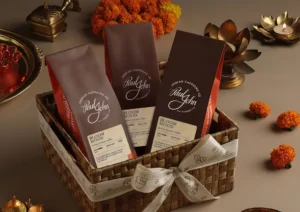
Traditional Indian Coffee Rituals: Brewing, Serving & Sharing
There’s something magical about the aroma of freshly brewed coffee at dawn. It’s not just about caffeine or starting the day—it’s about bringing families together,
There’s something magical about the aroma of freshly brewed coffee at dawn. It’s not just about caffeine or starting the day—it’s about bringing families together, welcoming guests with warmth, and celebrating the simple joys of life.
Traditional Indian coffee rituals are far more than just making a beverage; they’re a beautiful expression of hospitality, heritage, and community that deserves to be explored and celebrated.
Indian coffee culture is deeply woven into the social fabric of South India, where filter coffee—affectionately called kaapi—reigns supreme. Unlike the quick coffee runs common in other cultures, the Indian approach to coffee is unhurried and intentional. It’s a practice that demands patience, rewards mindfulness, and creates moments of genuine connection between people.
Walk into any traditional South Indian household, and you’ll likely witness this daily ritual unfold with care and precision. The process isn’t rushed because it isn’t meant to be. It’s a moment to pause, breathe, and appreciate the craftsmanship that goes into every cup.
The brewing method used for traditional Indian coffee is distinctive and has remained largely unchanged for generations. At the center of this process is a simple yet ingenious device—the metal coffee filter, usually made of brass or stainless steel. This two-chambered filter is the heart of Indian coffee brewing methods and can be found in kitchens across South India.
Here’s how the magic happens. Finely ground coffee beans, often blended with chicory in a ratio of about seventy to thirty percent, are placed in the upper chamber of the filter. The grounds are then pressed down gently with a perforated disc to create an even surface. Hot water, heated to just the right temperature, is poured slowly over the coffee grounds and left to work its magic.
Over the next ten to fifteen minutes, the water percolates through the grounds, extracting every bit of flavor and aroma, and drips into the lower chamber as a concentrated decoction. This slow extraction is what gives traditional Indian coffee its characteristic robust flavor and intoxicating aroma that fills the entire home.
The decoction itself is incredibly strong—too strong to drink on its own. That’s where the artistry of blending comes in. The decoction is mixed with freshly boiled milk and sugar, typically in a ratio of one part decoction to three parts milk, creating a perfectly balanced, creamy beverage that’s both comforting and energizing.
The addition of chicory isn’t just about stretching the coffee supply or cutting costs. It adds an earthy depth and slight bitterness that beautifully complements the sweetness of milk and sugar, creating a flavor profile that’s uniquely Indian.
If the brewing is the heart of Indian coffee heritage, then the serving ritual is its soul. Traditional Indian coffee is served in a pair of iconic vessels—the dabara and tumbler—both typically made of brass or stainless steel. The dabara is a shallow, wide bowl, while the tumbler is a smaller, narrower cup. Together, they create one of the most distinctive coffee-serving traditions in the world.
The real artistry happens in the pouring. The hot coffee is poured back and forth between the dabara and tumbler from a height, sometimes with the vessels held as far apart as an arm’s length. This isn’t just showmanship, though it certainly looks impressive. This technique serves several practical purposes that enhance the coffee experience.
First, it aerates the coffee, incorporating tiny bubbles that create the beloved frothy layer known as meter coffee. Second, it mixes the decoction, milk, and sugar thoroughly, ensuring every sip is perfectly balanced. Third, it cools the coffee to an ideal drinking temperature, so you can enjoy it immediately without burning your tongue.
But beyond the practical benefits, this pouring ritual symbolizes something deeper. It represents the care and hospitality that Indian coffee culture embodies. When someone takes the time to pour your coffee this way, they’re saying you matter, you’re welcome, and your comfort is important to us.
Also Read: Everything You Need to Know About Our Single-Origin Coffee
The true essence of coffee rituals in India reveals itself in how coffee is shared. In Indian homes, offering coffee to a guest is one of the first acts of hospitality. It’s not unusual for visitors to be greeted with a warm cup of filter coffee within minutes of arrival, served with genuine warmth and a smile.
Sharing coffee in Indian homes is a daily practice that strengthens family bonds. Morning coffee sessions bring family members together before they scatter to their various responsibilities. Evening coffee breaks provide opportunities to reconnect, share stories about the day, and simply enjoy each other’s company.
The communal nature of Indian coffee culture extends beyond homes to the beloved coffee houses that dot South Indian cities. The iconic Indian Coffee House chains have served as social hubs for decades, hosting everyone from students cramming for exams to intellectuals debating politics and philosophy. These spaces are democratic and inclusive, where coffee acts as the great equalizer, bringing people from all walks of life together over a shared cup.
What makes traditional Indian coffee taste so distinctive? It’s a combination of several factors. The chicory blend adds earthiness and body. The use of rich, creamy milk creates a luxurious texture. Generous amounts of sugar balance the robust coffee and chicory bitterness. Some families also add a pinch of cardamom, infusing the coffee with aromatic warmth and a subtle spice note that’s both comforting and invigorating.
The brass filter itself contributes to the taste, imparting a subtle metallic note that longtime filter coffee drinkers find nostalgic and essential to the authentic experience.
This isn’t a bug—it’s a feature that distinguishes traditional Indian coffee from coffee brewed through paper filters or modern machines.
Traditional Indian coffee rituals offer something precious: an invitation to slow down, especially in an age where instant gratification reigns supreme. They remind us that some things cannot and should not be rushed. The fifteen minutes it takes to brew filter coffee, the careful pouring between vessels, the time spent sitting with loved ones over a cup—these aren’t inefficiencies to be optimized away. They’re the point.
These coffee rituals teach mindfulness, patience, and presence. They create space for conversation and connection in ways that grabbing coffee on the go simply cannot. They link us to our ancestors, to cultural traditions that have been lovingly preserved and passed down through generations.
Also Read: Beginner’s Guide to Coffee: How to Go from Coffee Novice to Connoisseur
Traditional Indian coffee rituals encompass far more than brewing technique or serving style. They represent a complete philosophy of hospitality, community, and appreciating life’s simple pleasures.
From the patient brewing process using the brass filter to the artistic pouring between dabara and tumbler, from the rich, frothy taste to the meaningful conversations shared over each cup—every aspect of Indian coffee culture celebrates human connection and cultural heritage.
At Paul John Caffeine, we carry that same spirit forward — crafting coffees that honor tradition while embracing today’s coffee culture. Explore our collection and bring a touch of India’s warmth to every brew.

There’s something magical about the aroma of freshly brewed coffee at dawn. It’s not just about caffeine or starting the day—it’s about bringing families together,

There’s something magical about the aroma of freshly ground coffee wafting through your kitchen on a sleepy morning. If you’ve ever wondered why your homemade

Celebrating Diwali is more than just a festival — it’s a feeling. From the shopping and cleaning to decorating the house and making rangolis, it’s